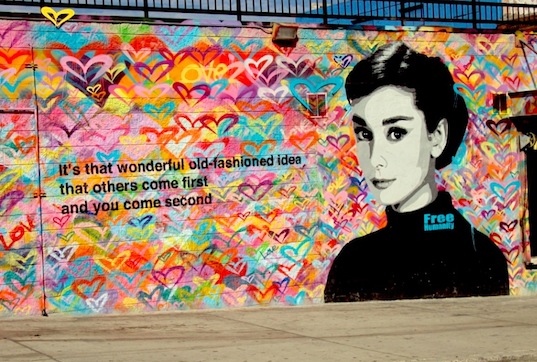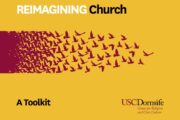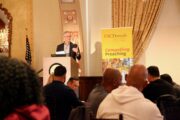A lot has been written recently about the spiritual-but-not-religious crowd, or the “religious nones”–people who have no particular religious affiliation–and how their numbers are rapidly growing in the U.S. Recent reports place “nones” between just under 20 percent to as much as 23 percent of American adults. The largest segment of the population that claims no religious affiliation are young people under 30 years of age (32 percent), with the next-least-affiliated group those between 30 and 49 (21 percent).
Closer analysis of these trends reveal that the majority of the “nones” are interested in spirituality, and many are still drawn toward certain religious practices. But regardless of how this development is described or measured, the upshot is that people are going to religious services less frequently than in previous generations, and our traditional definitions of religion and religious institutions are mattering less in the daily lives of younger Americans. In our view, however, this does not mean that we are entering a new age of atheism or irreligion, but instead signals what we would describe as a coming wave of religious indifference.
Among the many reasons for the increasing numbers of “nones” and the decreasing ability of religious organizations to successfully appeal to people who otherwise have some religious affinity, we suggest the following five are the most important:
- Traditional authority structures, including religious ones, have been flattened through broad access to knowledge. As a result, everyone and no one is an authority, which reduces the need for traditional “authorities” of any sort, let alone religious authorities. This democratization of knowledge has demystified all forms of authority, with that of a religious nature taking a particularly bad hit. Traditional religious groups, denominations, congregational leaders, etc. have yet to fully acknowledge, let alone respond to this change.
- As urban and suburban communities become more diverse, differences between groups, whether these are cultural, racial, ethnic or religious, have become less important. When you grow up with friends and neighbors who are as likely to be different from you as they are to be similar to you, those differences mean less. Yet religious groups have not been able to address how the coming together of a multitude of communities can potentially relativize the beliefs, practices and experiences of their members.
- Religion has a bad brand. From the hyper-politicization of evangelicalism beginning in the 1970s to the recent Supreme Court decision in favor of Hobby Lobby’s religious exemption to parts of the Affordable Care Act, religion per se has taken a beating. Many younger people we have come across, including those from seemingly successful groups like evangelicals, are reluctant to identify themselves as “religious.” Instead of darkening the door of their local congregation, they have begun meeting fellow travelers in private homes, bars, coffee shops and the like, often without the participation of a traditional minister of any sort. The unorthodox venue and the absence of “authorized” religious personnel, combined with the likelihood that some source other than a classical sacred text is often the focus of discussion, suggests a further distancing from traditional forms of religious expression.
- Increasing competition for the attention of potentially religious people from work, family responsibilities, social media and other activities means that religion more often loses out to commitments that people deem more important to the formation of identity, meaning and community. Involvement with a religious group often appears to be yet another social chore rather than a time of reflection, conversation and renewal. Who needs that?
- If American culture is defined by any one concept, it is personal choice. Individuals choose professional affiliations, diets, club memberships and myriad other associations, yet religious institutions have been slow to recognize and respond to what people might want from their spiritual communities. And even those that have been responsive to this ethic of individual choice, such as megachurches, have often been unwitting drivers of the trends that send people out the church doors. Why go to church to meet friends for coffee or shopping when there are many options for those activities that offer a greater sense of authenticity and spontaneity?
The “nones” category is admittedly fuzzy, often inviting the argument that religiosity is just hidden or obscured because people aren’t doing religion in traditional ways and in traditional venues. But the bottom line is that the data show consistently and clearly that over time formal religious institutions are losing ground in our social culture. The weekly trip to a brick-and-mortar sacred space for communion with fellow believers has been replaced by personalized rituals of mimosas with girlfriends, yoga classes or informal conversations with others who no longer find relevance in the rules and creeds that molded the lives of earlier generations.
So what might be the result of this rising indifference to traditional religion? A new religious revitalization that speaks to the needs, demands and cultural sensibilities of the nones might somehow take place, but this seems unlikely to sweep up those currently being pushed out. In the face of what should be considered a crisis, or at least a significantly shrinking pool of potential members/attenders, the majority of religious institutions—from denominations to congregations— have demonstrated a remarkable inability to innovate and adapt to the challenges they are facing. In our observations, most groups continue to try to shoe-horn people into existing programs instead of actually talking to them about what they might want in a religious community. Traditions that are inherently authoritarian and hierarchically organized may ultimately be facing an insurmountable challenge from a generation that simply doesn’t understand authority, membership, meaning and belonging in the same way.
It bears repeating, however, that most of the “nones” remain interested in developing a spiritual identity, or at least in forming communities of like-minded people. But these pursuits are taking place outside of traditional religious venues and involve activities such as meditation in which the locus of authority is the individual, who chooses how involved in the group she or he wants to be.
We propose that there will be greater polarization of religion, with a small and fervent group of religious progressives on the political left and a bigger (but still small) and even more fervent group of religious conservatives on the political right. The religious right will continue to be a political force, exercising influence that far exceeds its numbers. And religious progressives will struggle to find a foothold politically as they realize they are unable to attract those “nones” who might be sympathetic to their social message, into their staid religious institutions.
Furthermore, we predict that this volatile religious climate will sharpen existing political divides in our country. Many highly religious people will dig in deeper, and this digging in, largely through political means that amplify a steadily waning cultural influence, will ultimately foster greater religious indifference among an increasingly larger portion of the American public. If religion fueled the culture wars of the last three or four decades, the rise of the “nones”—which is, in part, a reaction to that recent history—will serve to make matters worse, in the near term. The United States is unlikely to take the secular turn of Western Europe, but the outlines of the next Great Awakening, if there is to be one, are too far over the horizon to make out just yet.
Richard Flory is the executive director of the USC Center for Religion and Civic Culture.
Brie Loskota is the former executive director (2016-2021) of the USC Center for Religion and Civil Culture.
Rebecca Sager is a guest contributor with the USC Center for Religion and Civic Culture.







